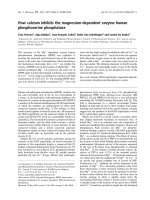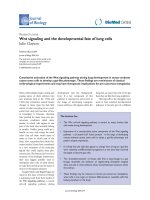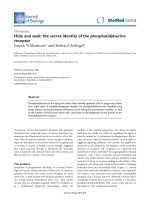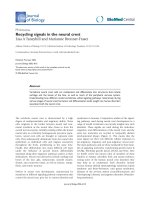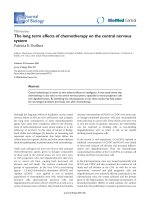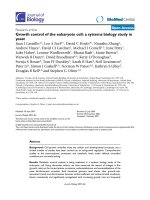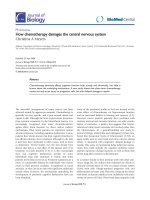Báo cáo sinh học: "How chemotherapy damages the central nervous system Christina A Meyers" ppsx
Bạn đang xem bản rút gọn của tài liệu. Xem và tải ngay bản đầy đủ của tài liệu tại đây (82.05 KB, 3 trang )
Minireview
HHooww cchheemmootthheerraappyy ddaammaaggeess tthhee cceennttrraall nneerrvvoouuss ssyysstteemm
Christina A Meyers
Address: Department of Neuro-Oncology, University of Texas MD Anderson Cancer Center, 1515 Holcombe Boulevard, Unit 431, Houston,
TX 77030, USA. Email:
The successful management of many cancers has been
achieved mainly by aggressive treatment. Chemotherapy is
generally not very specific, and it puts normal tissues and
organs at risk. Although the brain is given some protection
from systemic treatments by the blood-brain barrier, it is
increasingly recognized that many chemotherapeutic
agents affect brain function by direct and/or indirect
mechanisms. Thus, cancer patients can experience various
adverse symptoms, including cognitive dysfunction. Cancer
patients have always known that their cognitive function is
less efficient during cancer treatment, although in the past
it may have been attributed to other causes, such as stress
or depression. Several studies over the past decade have
shown that this is a real effect of the disease and of its
treatment on brain function [1-3]. It is also increasingly
clear that cognitive dysfunction persists in some
individuals long after treatment is ended, and some
patients never fully recover [3,4]. Persistent symptoms are a
cause of considerable distress for individuals who cannot
return to their previous academic, occupational or social
activities, or who can do so only with significant additional
mental effort. However, the mechanisms underlying the
development of persistent cognitive dysfunction have not
been identified.
Many of the preclinical studies so far have focused on the
acute effects of chemotherapy on hippocampal function
and on associated deficits in learning and memory [5-9].
However, cancer patients generally have problems with
memory retrieval and executive function, not with consoli-
dation of memories, a pattern that suggests that frontal-
subcortical white matter networks are involved rather than
the hippocampus. In a ground-breaking new study in
Journal of Biology, Mark Noble and colleagues [10] have now
found that therapeutic levels of 5-fluorouracil (5-FU), an
agent widely used to treat breast and colon cancers, among
others, is associated with progressive delayed damage to
myelin. This series of experiments helps define the mecha-
nisms that could underlie the cognitive problems cancer
patients experience during treatment, as well as those that
persist long after treatment is discontinued.
In a manner similar to their previous work with other anti-
cancer drugs [9], the authors first examined the effects of
clinically relevant doses of 5-FU on central nervous system
(CNS) stem cells, lineage-restricted progenitor cells and
differentiated cell types [10]. They also compared the effects
with those on human umbilical vein endothelial cells and a
variety of cancer cell lines. They found that progenitor cells
AAbbssttrraacctt
Chemotherapy adversely affects cognitive function both acutely and chronically, but little is
known about the underlying mechanisms. A new study shows that short-term chemotherapy
causes not only acute injury to progenitor cells, but also delayed damage to myelin.
BioMed Central
Journal of Biology
2008,
77::
11
Published: 22 April 2008
Journal of Biology
2008,
77::
11 (doi:10.1186/jbiol73)
The electronic version of this article is the complete one and can be
found online at />© 2008 BioMed Central Ltd
and nondividing oligodendrocytes were vulnerable, sugges-
ting that 5-FU neurotoxicity was not limited to dividing
cells. This toxicity was observed at lower concentrations
than generally used in other studies.
The authors then examined the effects of 5-FU on adult
mice. They found an acute, transient increase in apoptosis
in several brain regions, which subsided 56 days after
injection. They found a more persistent suppression of
proliferation in regions of the brain where proliferation is
essential to normal function (the subventricular zone, the
dentate gyrus of the hippocampus and the corpus callosum),
primarily in progenitor cells and oligodendrocytes. To
determine whether these findings resulted in functional
impairment, they investigated the auditory brainstem
response in the mice at various times following treatment.
Loss of myelin is known to increase the latency between
specific peaks in the auditory brainstem response, reflecting
slowing of the impulse conduction between the ear and the
brain. Exposure to 5-FU caused a progressive increase in
inter-peak latencies, consistent with developing myelin
damage, whereas cochlear function was not affected.
To follow up on this indication that delayed white matter
injury was the result of 5-FU exposure, Noble and
colleagues [10] undertook a more systematic investigation
of oligodendrocyte biology in the corpus callosum. They
found extensive damage to myelin, altered transcriptional
regulation in oligodendrocytes and extensive myelin
pathology 56 days after exposure to 5-FU. In contrast, CNS
inflammation and vascular damage, which have been
widely speculated to be underlying mechanisms of delayed
CNS injury, were acute rather than delayed and thus did not
seem to be related to the delayed demyelination.
OOtthheerr pprreecclliinniiccaall ssttuuddiieess ooff cchheemmootthheerraappyy iinndduucceedd
CCNNSS iinnjjuurryy
Previous studies have shown that various chemotherapeutic
agents cause cognitive impairment, although the results are
variable. Winocur et al. [5] found that a combination of
methotrexate and 5-FU induced impairments in tests of
spatial memory and other cognitive tasks in mice. Reiriz et
al. [6] also reported transient acute memory impairment in
mice treated with a single dose of cyclophosphamide.
Adriamycin has been demonstrated to increase oxidative
stress in the brain, which may lead to cell dysfunction or
cell death and thus contribute to cognitive dysfunction [7].
Crandall et al. [8] reported that long-term exposure to 13-
cis-retinoic acid, which is often used in chemotherapy
regimens, was associated with decreased neurogenesis and
cell proliferation in the hippocampus and subventricular
zone, and with impaired spatial learning and memory in
young adult mice. Dietrich et al. [9] found that three widely
used chemotherapy agents (carmustine, cisplatin and cyto-
sine arabinoside) were more toxic to CNS progenitor cells
and nondividing oligodendrocytes than to many cancer cell
lines in vitro. They also found that the agents caused
increased cell death and decreased cell division in the
subventricular zone, the dentate gyrus of the hippocampus
and the corpus callosum in mice. These effects were
observed for weeks after drug administration ended.
In contrast, Lee et al. [11] found transient improvement in
memory and synaptic plasticity in rats treated with cyclo-
phosphamide or 5-FU 8 weeks after administration, but not
29 to 42 weeks later, when the treated rats performed no
differently from controls. This group did, however, find
impaired long-term potentiation (a phenomenon critical
for learning) in hippocampal slices taken during cyclo-
phosphamide treatment, whereas they found enhanced
long-term potentiation in slices obtained 8 and 53 weeks
after treatment [11]. Thus, some of the variability of the
results in these studies may be related to the time points of
evaluation (acute versus chronic toxicity), the different
agents under study, and the specific animal or preclinical
model that was utilized.
CClliinniiccaall ssttuuddiieess
The studies of Noble and colleagues [9,10] will directly
affect clinical research into the pattern of cognitive dys-
function in cancer patients and the associated imaging and
physiological results. The incidence of acute chemotherapy-
related cognitive dysfunction ranges from 15 to 70% [3,12].
One trial found that 61% of women receiving 5-FU, doxo-
rubicin and cyclophosphamide for breast cancer showed a
decline in cognitive function while on treatment. The
decline occurred most often in attention, learning and
processing speed and was not related to mood, demo-
graphic characteristics, clinical features or baseline level of
cognitive function [3]. Consistent with the findings of
Noble and colleagues [10], 50% of the women had not
recovered 1 year after treatment was discontinued [3]. Long-
term cognitive impairments have also been reported in
cross-sectional studies of patients 2-10 years after treatment
ended [4,13,14].
The findings of Noble and colleagues regarding delayed
white matter injury and associated functional impairment
may provide a mechanistic basis for the results of studies in
cancer patients. A recent study of breast cancer survivors
3-6 years after chemotherapy was completed found that
patients had abnormalities in the processing of an auditory
stimulus compared with controls [15]. Interestingly, all of
the patients had received 5-FU as part of their treatment
11.2
Journal of Biology
2008, Volume 7, Article 11 Meyers />Journal of Biology
2008,
77::
11
regimen. Silverman et al. [16], using positron emission
tomography, found alterations in resting metabolism and
cerebral blood flow in the basal ganglia, inferior frontal
gyrus and cerebellum during memory activation in women
who had received chemotherapy 5-10 years earlier.
Anatomical studies have also found changes in cancer
survivors treated with chemotherapy. Using magnetic
resonance imaging, Inagaki et al. [17] found smaller gray
and white matter volumes in multiple brain regions 1 year
after treatment compared with controls, although this was
not observed in a cohort scanned 3 years after treatment.
The reduced volumes at 1 year correlated with poorer
performance on cognitive testing. Gray and white matter
volume loss and hippocampal atrophy have also been
reported in association with some chemotherapeutic treat-
ments [18-20]. However, these findings have not always
been replicated, suggesting the need for further investi-
gation [21].
The findings of Noble and colleagues [9,10] have greatly
contributed to our understanding of the mechanisms of
acute and, importantly, progressive and delayed injury to
the brain from clinically relevant short-term exposure to a
widely used chemotherapy agent. Furthermore, their results
are consistent with the clinical syndrome commonly
observed in patients. This important study [10] underscores
the need for varied and appropriate preclinical models that
assess both acute and progressive delayed CNS injury due to
cancer treatment. The knowledge gained from this and
other studies will guide the development of translational
clinical research to protect the nervous system from injury,
to better treat injury that has developed as a result of
treatment, and to improve the overall quality of life of
cancer patients.
RReeffeerreenncceess
1. Alvarez JA, Scully RE, Miller TL, Armstrong FD, Constine LS,
Friedman DL, Lipschultz SE:
LLoonngg tteerrmm eeffffeeccttss ooff ttrreeaattmmeennttss ffoorr
cchhiillddhhoooodd ccaanncceerrss
Curr Opin Pediatr
2007,
1199::
23-31.
2. Schagen SB, Muller MJ, Boogerd W, Mellenbergh GJ, van Dam
FSAM:
CChhaannggee iinn ccooggnniittiivvee ffuunnccttiioonn aafftteerr cchheemmootthheerraappyy:: aa
pprroossppeeccttiivvee lloonnggiittuuddiinnaall ssttuuddyy iinn bbrreeaasstt ccaanncceerr ppaattiieennttss
J Natl
Cancer Inst
2006,
9988::
1742-1745.
3. Wefel JS, Lenzi R, Theriault R, Davis RN, Meyers CA:
TThhee ccooggnnii
ttiivvee sseeqquueellaaee ooff ssttaannddaarrdd ddoossee aaddjjuuvvaanntt cchheemmootthheerraappyy iinn wwoommeenn
wwiitthh bbrreeaasstt ccaanncceerr:: rreessuullttss ooff aa pprroossppeeccttiivvee,, rraannddoommiizzeedd,, lloonnggiittuuddii
nnaall ttrriiaall
Cancer
2004,
110000::
2292-2299.
4. Ahles TA, Saykin AJ, Furstenberg CT, Cole B, Mott LA, Skalla K,
Whedon MB, Bivens S, Mitchell T, Greenberg ER, Silberfarb PM:
N
eeuurrooppssyycchhoollooggiiccaall iimmppaacctt ooff ssttaannddaarrdd ddoossee ssyysstteemmiicc cchheemmootthheerr
aappyy iinn lloonngg tteerrmm ssuurrvviivvoorrss ooff bbrreeaasstt ccaanncceerr aanndd llyymmpphhoommaa
J Clin
Oncol
2002,
2200::
485-493.
5. Winocur G, Vardy J, Binns MA, Kerr L, Tannock I:
TThhee eeffffeeccttss ooff
tthhee aannttii ccaanncceerr ddrruuggss,, mmeetthhoottrreexxaattee aanndd 55 fflluuoorroouurraacciill oonn ccooggnnii
ttiivvee ffuunnccttiioonn iinn mmiiccee
Pharmacol Biochem Behav
2006,
8855::
66-75.
6. Reiriz AB, Reolon GK, Preissler T, Rosado JO, Henriques JAP,
Roesler R, Schwartsmann G:
CCaanncceerr cchheemmootthheerraappyy aanndd ccooggnniittiivvee
ffuunnccttiioonn iinn rrooddeenntt mmooddeellss:: mmeemmoorryy iimmppaaiirrmmeenntt iinndduucceedd bbyy
ccyycclloopphhoosspphhaammiiddee iinn mmiiccee
Clin Cancer Res
2006,
1122::
5000.
7. Joshi G, Sultana R, Tangpong J, Cole MP, St Clair DK, Vore M,
Estus S, Butterfield DA:
FFrreeee rraaddiiccaall mmeeddiiaatteedd ooxxiiddaattiivvee ssttrreessss aanndd
ttooxxiicc ssiiddee eeffffeeccttss iinn bbrraaiinn iinndduucceedd bbyy tthhee aannttii ccaanncceerr ddrruugg aaddrrii
aammyycciinn:: iinnssiigghhtt iinnttoo cchheemmoobbrraaiinn
Free Radical Res
2005,
3399::
1147-
1154.
8. Crandall J, Sakai Y, Zhang J, Koul O, Mineur Y, Crusio WE, McCaf-
frey P:
1133
cciiss
rreettiinnooiicc aacciidd ssuupppprreesssseess hhiippppooccaammppaall cceellll ddiivviissiioonn aanndd
hhiippppooccaammppaall ddeeppeennddeenntt lleeaarrnniinngg iinn mmiiccee
Proc Natl Acad Sci USA
2004,
110011::
5111-5116.
9. Dietrich J, Han R, Yang Y, Mayer-Pröschel M, Noble M:
CCNNSS pprroogg
eenniittoorr cceellllss aanndd oolliiggooddeennddrrooccyytteess aarree ttaarrggeettss ooff cchheemmootthheerraappeeuuttiicc
aaggeennttss
iinn vviittrroo
aanndd
iinn vviivvoo
J Biol
2006,
55::
22.
10. Han R, Yang YM, Dietrich J, Luebke A, Mayer-Pröschel M, Noble
M:
SSyysstteemmiicc 55 fflluuoorroouurraacciill ttrreeaattmmeenntt ccaauusseess aa ssyynnddrroommee ooff ddeellaayyeedd
mmyyeelliinn ddeessttrruuccttiioonn iinn tthhee cceennttrraall nneerrvvoouuss ssyysstteemm
J Biol
2008,
77::
12.
11. Lee GD, Longo DL, Wang Y, Rifkind JM, Abdul-Raman L, Mam-
czarz JA, Duffy KB, Spangler EL, Taub DD, Mattson MP, Ingram
DK:
TTrraannssiieenntt iimmpprroovveemmeenntt iinn ccooggnniittiivvee ffuunnccttiioonn aanndd ssyynnaappttiicc
ppllaassttiicciittyy iinn rraattss ffoolllloowwiinngg ccaanncceerr cchheemmootthheerraappyy
Clin Cancer Res
2006,
1122::
198-205.
12. Moleski M:
NNeeuurrooppssyycchhoollooggiiccaall,, nneeuurrooaannaattoommiiccaall,, aanndd nneeuurroopphhyyssii
oollooggiiccaall ccoonnsseeqquueenncceess ooff CCNNSS cchheemmootthheerraappyy ffoorr aaccuuttee llyymm
pphhoobbllaassttiicc lleeuukkeemmiiaa
Arch Clin Neuropsychol
2000,
1155::
603-630.
13. Schagen SB, van Dam FS, Muller MJ, Boogerd W, Lindeboom J,
Bruning PF:
CCooggnniittiivvee ddeeffiicciittss aafftteerr ppoossttooppeerraattiivvee cchheemmootthheerraappyy
ffoorr bbrreeaasstt ccaarrcciinnoommaa
Cancer
1999,
8855::
640-650.
14. Castellon SA, Ganz PA, Bower JE, Petersen L, Abraham L, Green-
dale GA:
NNeeuurrooccooggnniittiivvee ppeerrffoorrmmaannccee iinn bbrreeaasstt ccaanncceerr ssuurrvviivvoorrss
eexxppoosseedd ttoo aaddjjuuvvaanntt cchheemmootthheerraappyy aanndd ttaammooxxiiffeenn
J Clin Exp Neu-
ropsychol
2004,
2266::
955-969.
15. Kreukels BP, Hamburger HL, de Ruiter MB, van Dam FS, Rid-
derinkhof KR, Boogerd W, Schagen SB:
EERRPP aammpplliittuuddee aanndd llaatteennccyy
iinn bbrreeaasstt ccaanncceerr ssuurrvviivvoorrss ttrreeaatteedd wwiitthh aaddjjuuvvaanntt cchheemmootthheerraappyy
Clin Neurophysiol,
2008,
111199::
533-541.
16. Silverman DH, Dy CJ, Castellon SA, Lai J, Pio BS, Abraham L,
Waddel Petersen L, Phelps MR, Ganz PA:
AAlltteerreedd ffrroonnttooccoorrttiiccaall,,
cceerreebbeellllaarr aanndd bbaassaall ggaanngglliiaa aaccttiivviittyy iinn aaddjjuuvvaanntt ttrreeaatteedd bbrreeaasstt
ccaanncceerr ssuurrvviivvoorrss 55 1100 yyeeaarrss aafftteerr cchheemmootthheerraappyy
Breast Cancer
Res Treat
2007,
110033::
303-311.
17. Inagaki M, Yoshikawa E, Matsuoka Y, Sugawara Y, Nakano T,
Akechi T, Wada N, Imoto S, Murakami K, Uchitomi Y:
SSmmaalllleerr
rreeggiioonnaall vvoolluummeess ooff bbrraaiinn ggrraayy aanndd wwhhiittee mmaatttteerr ddeemmoonnssttrraatteedd iinn
bbrreeaasstt ccaanncceerr ssuurrvviivvoorrss eexxppoosseedd ttoo aaddjjuuvvaanntt cchheemmootthheerraappyy
Cancer
2007,
110099::
146-156.
18. Schneiderman B:
HHiippppooccaammppaall vvoolluummeess ssmmaalllleerr iinn cchheemmootthheerraappyy
ppaattiieennttss
Lancet Oncol
22000044,, 55::
202.
19. Saykin AJ, Ahles TA, McDonald BC:
MMeecchhaanniissmmss ooff cchheemmootthheerraappyy
iinndduucceedd ccooggnniittiivvee ddiissoorrddeerrss:: nneeuurrooppssyycchhoollooggiiccaall,, ppaatthhoopphhyyssiioollooggii
ccaall,, aanndd nneeuurrooiimmaaggiinngg ppeerrssppeeccttiivveess
Semin Clin Neuropsychiatr
2003,
88::
201-216.
20. Madhyastha S, Somayaji SN, Rao MS, Nalini K, Bairy KL:
HHiipp
ppooccaammppaall bbrraaiinn aammiinneess iinn mmeetthhoottrreexxaattee iinndduucceedd lleeaarrnniinngg aanndd
mmeemmoorryy ddeeffiicciitt
Can J Physiol Pharmacol
2002,
8800::
1076-1084.
21. Yoshikawa E, Matsuoka Y, Inagaki M, Nakano T, Akechi T,
Kobayakawa M, Fujimori M, Nakaya N, Akizuki N, Imoto S,
Murakami K, Uchitomi Y.
NNoo aaddvveerrssee eeffffeeccttss ooff aaddjjuuvvaanntt
cchheemmootthheerraappyy oonn hhiippppooccaammppaall vvoolluummee iinn JJaappaanneessee bbrreeaasstt ccaanncceerr
s
suurrvviivvoorrss
Breast Cancer Res Treat
2005,
9922::
81-84.
/>Journal of Biology
2008, Volume 7, Article 11 Meyers 11.3
Journal of Biology
2008,
77::
11
